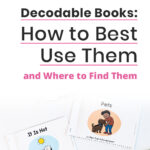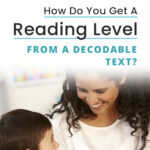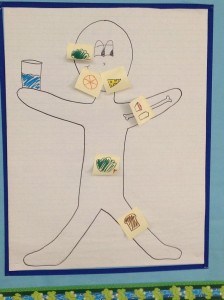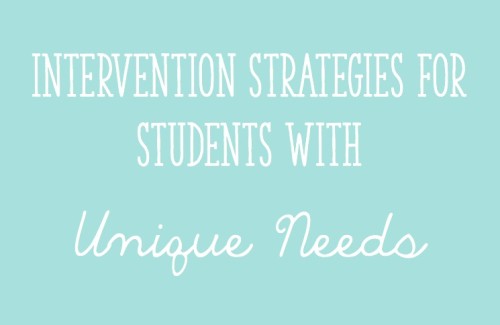Read-alouds in Kindergarten, first grade, and second grade are often a favorite time of day for both teachers and students! There are a couple of ways to go about facilitating a read-aloud.
- You may have a fairly specific curriculum that tells you exactly which standards to teach and also provides you with the texts/books for that standard.
- Sometimes, you’re given an objective or standard and then get to choose a book to support those skills.
- Or sometimes you just have a book you enjoy and want to share with the class, or it relates to something seasonal! So should you always have an objective? Can you read aloud a book just to…well…read a book?!
In this post, I’ll answer these questions and explain exactly how to take any book and create a read-aloud lesson with it!
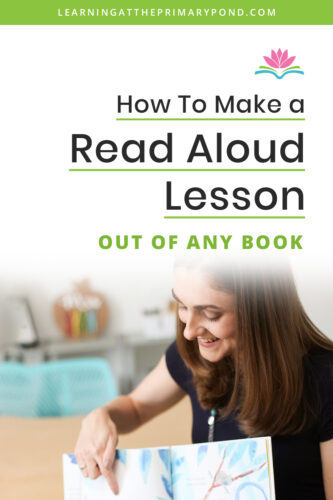
What Is a Read-Aloud?
A read-aloud occurs when you read a text or book to students. Many teachers like to have students come to a carpet or gathering space where students are a bit closer to the read-aloud text. This way, students can see the book up close (although they don’t need to be able to read the words).
During a read-aloud, you do the actual decoding, while the students listen and engage in other ways (which we’ll get to a bit later in this post!)
Typically, read-alouds take about 10-15 minutes, not counting any follow-up activities you may do with them.
What are the Benefits of a Read-Aloud?
By reading aloud, you’re giving students access to more challenging text than what they could decode on their own.
Read-alouds are great for working on skills that don’t require students to be able to see and decode the text. With a read-aloud, you can engage students in higher-level thinking since the text may be more challenging than texts that K-2 students could read independently.
When students hear teachers read aloud, they are listening to fluent reading. This is a key component for literacy success. Students also may be learning new vocabulary – especially when you stop to teach words.
If you want to read a bit more about the differences between read-alouds, shared reading, and guided reading, check out a blog post I wrote: “Read-Aloud, Shared Reading, Guided Reading: What’s the Difference?”
Steps for Planning and Facilitating a Read Aloud Lesson
In this section, I’ll explain what I do, step by step, to plan a read-aloud. I typically prefer to identify my purpose for the read-aloud first. But sometimes you just have an amazing book that you really want to use!
If you do start with a book and then identify your purpose second, make sure to ask yourself, “Does this book really lend itself to the skill I want to teach?” For instance, if you choose a book and it doesn’t really have one clear-cut problem, don’t try and teach problem/solution with it!
Identify Your Purpose:
Based upon your standards or curriculum map, what comprehension or vocabulary skill do you need to cover?
Your read-aloud goal might be to teach:
- Basic story elements (characters, setting)
- Sequencing events in a story
- Problem/solution
- Characters (feelings, comparing/contrasting 2 characters, etc.)
- Making predictions/inferences
- Inferring the meaning of vocabulary words from context
But just choose one goal! Many books lend themselves to multiple skills, but you don’t want to overwhelm your students by asking them to focus on too many things at once.
You might also read a text aloud for a specific purpose that isn’t a comprehension or vocabulary skill. For example, you might read a story aloud if it contains an important lesson that could be helpful in building classroom community or teaching social skills. Or you might read a book about habitats aloud to go with your science instruction on habitats.
And sometimes your purpose for the read-aloud might be…student enjoyment! It’s wonderful to read a book aloud so your students can enjoy the story, the humor in the text, the illustrations, etc. Check out a blog post I wrote on this topic: “3 Reasons Why It’s Okay to Do a Readaloud (Just for the Sake of Doing a Readaloud).”
Choose a Book:
First, consider if you will use a new book or a book that you’ve already read aloud to students. It can be very helpful to work on a comprehension skill once students have already listened to a text once. This way, they will have had an opportunity to just work on understanding the text, and their minds will be ready to do more with the text (i.e. discuss inferences) the second or third time you read it.
If you’ll be using a new book, however, make sure you read the book (or re-read it if it’s been a while since you read it).
Plan Stopping Points:
Next, you’ll want to plan stopping points where you’ll do some or all of the following:
- Do a think-aloud
- Write something on chart paper
- Ask students a question (and they raise their hands to answer)
- Ask students to speak with a partner to answer a question
- Ask students to jot down something on a sticky note or paper (best for students who can write with some level of fluency)
Some teachers like to have a formal plan with page numbers and full questions written out. Others may use a more informal approach, such as putting sticky notes in the book with questions on them. Either way, it’s important to plan for whatever pages you’d like to stop on.
The first time I stop during a read-aloud, I usually do a think-aloud. Here, I’m modeling a comprehension or thinking strategy for students. For example: “Hmm, it sounds as if things aren’t going well for Lena. She doesn’t think she can play in her basketball game because her ankle is really sore. I wonder what may happen next?”
If the skill lends itself to creating a visual chart, I could jot something down. For example, if we were working on comparing and contrasting characters, I could write down a detail in a Venn diagram if it came up in the text.
The next time I have a teaching point, it’s usually more of a “we do” where the students and I work together. This could be a question I raise to the entire class such as “What is happening with Lena right now that could be a problem?” If we’re working on a chart or Venn diagram, I can add to the chart again.
You don’t want to have too many stopping points to disrupt the overall flow of the book. But you DO want to stop enough to work through whatever objective you’ve chosen and clear up any possible points of confusion for students.
Generally speaking, I try to keep a read-aloud as interactive as possible. Four out of five times, I’ll ask a question and have students answer to a partner – before having students raise their hands to share out. Using this “think pair share” approach instead of “ask a question and raise hands” gives more students opportunities to do the thinking and talking work.
When students can write reasonably well, you can also have them write down their thoughts during a read-aloud or after a read-aloud.
Plan Extension Activities (if applicable):
I don’t have an extension activity for every read-aloud that I do. However, sometimes you might have students:
- Answer a writing prompt
- Do a comprehension activity, like fill out a graphic organizer
- Complete an art activity or related craft
Students would do this back at their seats. You could even begin pulling small groups while they work.
Conclusion
I hope these tips are helpful to you in planning read-alouds! Remember, read-alouds can be laid back (i.e. reading for pure joy and relaxation!) or more formal (reading to work on a specific comprehension strategy). It’s good to have a mix!
I’d love to hear about some of your favorite read-aloud books in the comments below. Please share which have been successes in your own classrooms or ones you remember from your childhood!
Happy teaching!


